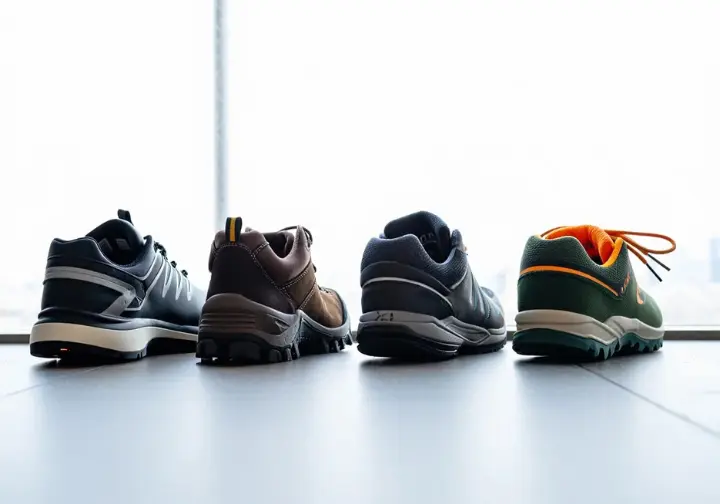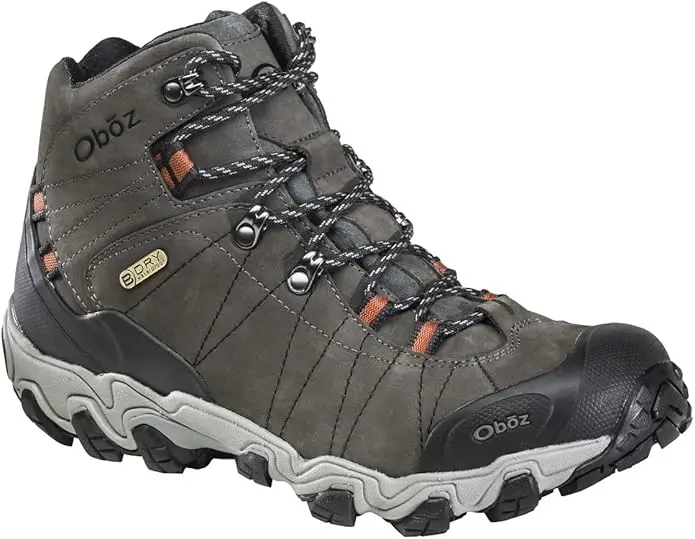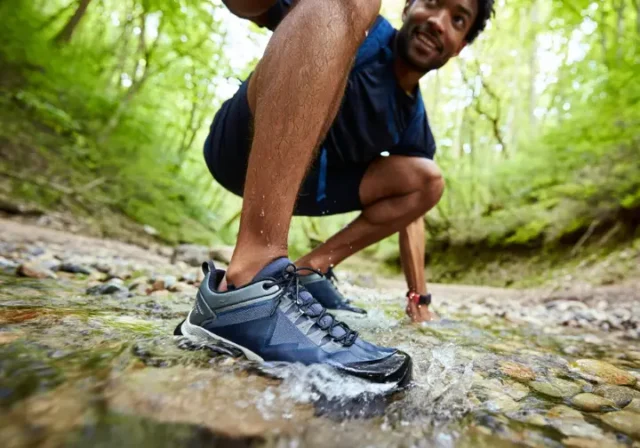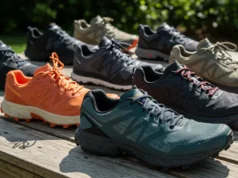In this article
The allure of mens waterproof hiking shoes is powerful, promising dry feet through mud, rain, and wet grass. Yet, the technology that seals water out can also trap sweat in, creating a complex trade-off for any hiker. This guide to hiking footwear will help you understand when to choose waterproof shoes versus when a non-waterproof option is a smarter choice. We’ll explore the science behind GORE-TEX and other membranes, see how components like the midsole and outsole affect performance, and provide data-driven reviews of the best waterproof hiking shoes mens models for 2025.
The Great Debate: Are Waterproof Shoes Always Better?

It’s a common misconception that “waterproof” is always the superior choice for hiking footwear. Deconstructing this idea requires exploring the critical trade-offs between blocking external water and managing the moisture your own feet produce during your hikes.
The Waterproof Promise vs. The Breathability Reality
The core conflict of any waterproof shoe is its inherent reduction in breathability compared to a non-waterproof shoe. A membrane is designed to block large water droplets from entering, but this same barrier inevitably restricts the escape of smaller water vapor molecules—sweat—from within the shoe. During high-exertion hiking or in warm weather, your feet can produce a lot of sweat. A waterproof model can trap this moisture, leading to clammy, wet feet—the very problem the shoe is meant to solve.
This internal wetness from trapped perspiration is a primary cause of discomfort and, more critically, the formation of painful blisters. Non-waterproof shoes, with their ventilated mesh uppers, allow this sweat to evaporate much more effectively. The ultimate goal for foot comfort is not just keeping external water out, but managing the total moisture environment around the foot. Understanding the importance of moisture-wicking hiking socks is a key part of this strategy, as is knowing how to approach preventing and treating hiking blisters.
Drying Times: The “Bucket Effect” When Soaked
The performance dynamic of waterproof footwear changes entirely once water gets inside, for example, during deep water crossings or a complete downpour that overtops the shoe’s collar. When this happens, a waterproof shoe transforms from a protective barrier into a “bucket.” The same membrane that prevents water from getting in now works just as effectively to prevent it from getting out. A waterlogged waterproof hiking shoe becomes extremely heavy and can take many hours, or even days, to dry completely because airflow through the membrane is minimal.
Prolonged dampness inside a shoe is a major cause of skin maceration, severe irritation, and debilitating blisters. In contrast, non-waterproof versions made with porous mesh and fabric drain almost instantly and dry significantly faster. This is a primary reason why many long-distance thru-hikers, who expect to get wet on their thru-hikes, overwhelmingly prefer non-waterproof trail running shoes. They prioritize quick-drying capabilities over water resistance, operating on the principle that wet feet are inevitable, but drying fast is crucial, a topic often seen in the ongoing the waterproof versus non-waterproof debate.
A Decision Framework for Your Hike
The choice between waterproof and non-waterproof footwear is not absolute but situational. You should base your decision on a clear assessment of climate, terrain, and your personal hiking preferences. Properly matching your boot to the trail type is fundamental to comfort and safety.
- Choose Waterproof Footwear When: Your day hikes are primarily in cool, damp, or cold climates. They excel on muddy, slushy, or snowy trails where moisture is a constant external threat. They are also ideal for shallow stream crossings, walking through dewy morning grass, or dealing with frequent but moderate rain showers where water is unlikely to flood over the cuff of the shoe.
- Choose Non-Waterproof Footwear When: You primarily hike in hot, dry climates. In these conditions, maximizing breathability to prevent your feet from overheating and sweating excessively is the top priority for comfort and foot protection. They are also the better choice when your route involves deep, unavoidable river or creek crossings. It is a better strategy to accept that your feet will get wet and wear shoes that will drain and dry out as quickly as possible.
- Choose Non-Waterproof Footwear When: You are focused on fast-and-light hiking or long-distance backpacking where minimizing weight is critical to reducing fatigue. The weight penalty of a waterproof membrane can become significant over thousands of steps on a long hiking trail.
The Science of Staying Dry: How Waterproofing Works

To make an informed choice, it helps to understand the technology behind the “waterproof” label, from leading membranes to chemical treatments that define a shoe’s waterproofing.
How GORE-TEX and ePTFE Membranes Work
GORE-TEX is the industry benchmark for fabrics with a breathable waterproof membrane, built around an expanded Polytetrafluoroethylene (ePTFE). This material is stretched to create a microporous structure with over 9 billion pores per square inch. The function of GORE-TEX is based on pore size: each pore is roughly 20,000 times smaller than a liquid water droplet, creating a physical barrier that rain and puddle water cannot penetrate from the outside. At the same time, each pore is about 700 times larger than a molecule of water vapor.
This dual function of blocking liquid water while allowing water vapor to pass is the definition of “waterproof breathable.” The waterproof membrane itself is incredibly thin (about 0.01 mm) and fragile, so it’s bonded to other textiles to create a durable laminate for use in footwear. These laminates come in 2-layer, 2.5-layer, or 3-layer constructions, which balance durability, weight, and cost. Learning about the science of the GORE-TEX membrane provides context for how similar waterproof membrane technologies in jackets also function.
GORE-TEX vs. Proprietary Membranes (Keen.Dry, B-DRY)
While GORE-TEX is the most recognized name, many footwear brands like Keen, Oboz, and Merrell have developed their own in-house waterproof membranes (e.g., Keen.Dry, B-DRY waterproof technology, M-Select DRY). These proprietary technologies operate on the same microporous principle as GORE-TEX but are developed primarily for cost control and product differentiation. While expert and user consensus generally holds that GORE-TEX provides the most reliable long-term waterproofing and breathability, some proprietary membranes perform very well. For example, Oboz’s B-DRY is regarded as highly waterproof, though many users find it less breathable than GORE-TEX. This makes it excellent for cold, wet conditions but potentially warm for summer hiking. When choosing boots with features like waterproofing, it’s useful to read an overview of proprietary waterproof membranes to compare them.
The Critical Role of DWR and Maintenance
The waterproof membrane is only part of the system. The boot’s first line of defense is the Durable Water Repellent (DWR) finish, a chemical treatment applied to the outer face fabric that provides water resistance. DWR works by causing water to bead up and roll off the surface of the shoe, preventing the outer material from becoming saturated, a condition known as “wetting out.”
Over time, this DWR finish wears off due to dirt, abrasion, and regular use. When this happens, the outer fabric will absorb water and become soaked. Even though the waterproof lining underneath may still be preventing water from reaching your foot, a wetted-out face fabric creates a cold, clammy layer that severely blocks the membrane’s ability to breathe, compromising the shoe’s overall waterproofness. Many hikers mistake this breathability failure for a leaking shoe. Their foot feels wet from trapped sweat, but the cause isn’t a hole in the membrane—it’s a failed DWR treatment. You can extend the functional life of your shoes by regularly cleaning them and reapplying a DWR treatment. This simple step of maintaining essential hiking equipment is crucial for restoring breathability.
Anatomy of a Hiking Shoe: What Matters Besides Waterproofing

A hiking shoe’s overall performance is a system of components working together. Understanding the midsole, outsole, and upper materials in the shoe construction is just as vital as understanding the waterproof liner.
Midsoles: The Cushioning vs. Durability Trade-Off (EVA vs. PU)
The midsole is the engine of the shoe, providing cushioning, shock absorption, and stability. The two most common materials are Ethylene-vinyl acetate (EVA) and Polyurethane (PU). EVA is a lightweight, flexible foam that offers excellent initial cushioning, giving shoes a soft, athletic feel. It’s the most common material in lightweight hiking shoes where comfort and low weight are priorities. Its main drawback is that it “packs out” over time, losing its ability to rebound, resulting in a loss of cushioning and support.
PU is a denser, heavier, and far more durable synthetic plastic. It is highly resistant to compression and provides consistent, long-lasting support and shock absorption for the life of the boot. Because of its durability, PU is the preferred midsole material for heavy-duty backpacking and mountaineering boots designed to carry heavy loads over rugged terrain. The distinction between midsole materials PU versus EVA is especially important for backpacking, where support for carrying heavy packs is critical.
Outsoles: Analyzing Traction and Grip (Vibram vs. Contagrip)
The outsole is the rubber layer that contacts the ground on trails, and its compound and lug pattern dictate the shoe’s traction. The two most dominant brands in high-performance outsoles are Vibram and Salomon’s proprietary Contagrip. Vibram is an Italian company that is the industry standard, supplying its rubber compounds to a huge number of footwear brands. Vibram Megagrip is one of its most popular compounds, renowned for its excellent balance of sticky grip and durability on both wet and dry surfaces. Contagrip is the in-house outsole technology developed and used exclusively by Salomon. Like Vibram, it comes in various formulas tailored for different types of terrain and activities. While both are high-quality, testing suggests Vibram Megagrip often has an edge on grip on wet rock and slippery roots. Contagrip is frequently praised for its exceptional braking and control on dry, loose, and mixed terrain. Understanding the differences in Contagrip vs Vibram outsoles helps when selecting shoes with aggressive lugs for off-road terrain.
Uppers: The Balance of Leather vs. Synthetic Materials
The upper is the part of the shoe that encloses the foot, and its materials dictate durability, support, weight, and breathability. The main choices are leather, synthetics, or a hybrid. Full-grain or nubuck leather is the traditional choice for a classic hiking boot, prized for its exceptional durability and ability to mold to the user’s foot over time. Its main drawbacks are heavier weight, a longer break-in period, and lower breathability compared to modern synthetics like nylon. Synthetic materials like polyester and mesh are significantly lighter, more breathable, and require little to no break-in.
The vast majority of modern hiking shoes use a hybrid construction. This approach strategically combines durable leather or suede in high-wear areas (like the heel and toe) with large synthetic mesh panels in other areas to maximize breathability and reduce weight. This hybrid design allows manufacturers to create a shoe that balances the key trade-offs, offering a good mix of durability, support, low weight, and breathability that suits a wide range of hikers. These choices in durable materials for hiking boots directly impact a shoe’s long-term performance.
The Best Men’s Waterproof Hiking Shoes of 2025

Our recommendations are a synthesis of professional field tests, long-term user reviews, and technical analysis. We’ve identified the top performers across key categories to help you find the right waterproof mens hiking shoes with confidence.
Best Overall & All-Around Performers
Merrell Moab 3 Mid WP | Legendary out-of-the-box comfort and unbeatable value for money

The Moab 3 Mid WP is legendary for its out-of-the-box comfort and unbeatable value. It features a pig suede leather and breathable mesh upper, Merrell’s proprietary waterproof membrane, and a Vibram TC5+ outsole for reliable traction. With a weight of about 2 lbs 2.9 oz per pair and a supportive midsole, it balances support and cushioning well for moderate hiking terrain. Users consistently praise its immediate comfort, effective waterproofing in moderate rain, and excellent value. However, it can feel bulky, may struggle in very muddy conditions, and the waterproof membrane can feel warm in hot weather. It’s ideal for day hiking and light backpacking on established trails where comfort and value are priorities. It stands out as a very good hiking shoe for those who prioritize comfort.
PROS
- Exceptional out-of-the-box comfort; no break-in.
- Reliable waterproofing for rain and puddles.
- Great traction and grip on varied surfaces.
CONS
- Can feel heavy and bulky compared to lighter shoes.
- Runs warm in hot weather, limiting breathability.
- Traction can struggle in very deep mud.
Keen Targhee IV WP | A durable workhorse with a famously roomy fit and robust protection

The Keen Targhee IV is a durable workhorse known for its roomy fit and robust protection. It features a premium nubuck leather upper, the KEEN.DRY waterproof membrane, and a KEEN.RUGGED outsole for long-lasting traction. A key feature is the “Original Fit” toe box that allows toes to splay naturally. Praised for its durability, reliable waterproofing, and roomy fit, it’s a favorite for those with wide feet. On the downside, it can feel heavy and stiff, and its breathability is limited in hot weather. The Targhee IV is best for three-season hiking applications on moderate to rugged trails, especially in wet or cooler conditions, as a durable hiking shoe.
PROS
- Very durable build that withstands rugged terrain.
- Roomy toe box is great for wider feet.
- Reliable waterproofing for wet conditions.
CONS
- Feels heavy and bulky on feet for long distances.
- Limited breathability makes feet warm in the heat.
- Wide fit may be too loose for narrow feet.
Danner Mountain 600 Leaf GORE-TEX | Classic style, modern lightweight comfort, and recraftable for sustainability

This boot blends classic Danner style with modern, lightweight comfort and is recraftable for sustainability. It uses a full-grain leather upper, a GORE-TEX liner with recycled materials, a Vibram SPE midsole, and a Vibram Fuga outsole with Megagrip for superior grip. Users love its exceptional comfort, reliable GORE-TEX waterproofing, and stylish hiking shoe design that works both on and off the trail. The recraftable feature also adds significant long-term value. Some find the ankle support insufficient for highly technical terrain, and the leather can feel thinner than traditional boots. It’s a highly versatile and lightweight hiking shoe for day hiking, light backpacking, and urban exploring in wet environments.
PROS
- Extremely comfortable with no break-in period.
- Vibram Megagrip offers superior wet/dry traction.
- Stylish design transitions well from trail to town.
CONS
- Ankle support may be lacking for rugged terrain.
- Full-grain leather feels thinner than expected.
- Can run warm in very hot weather conditions.
Best for Stability & Heavy Backpacking
Salomon Quest 4 GORE-TEX | The benchmark for stability and support when carrying heavy loads

The Salomon Quest 4 is the benchmark for stability and support when carrying heavy backpacks. Its design focuses on reducing muscle fatigue with an ADV-C 4D Chassis that cradles the foot and supports the ankles, providing exceptional support on challenging terrain. The boot combines a nubuck leather and textile upper with a GORE-TEX membrane and an All Terrain Contagrip outsole for confident grip. Users report outstanding stability, excellent comfort, and superior traction. However, it is relatively heavy and can run warm on warm days. This hiking boot is best suited for multi-day backpacking trips and challenging alpine terrain where a supportive hiking shoe is paramount.
PROS
- Outstanding stability for heavy loads and rough terrain.
- Superior traction and grip on mixed surfaces.
- Highly protective build with a great rubber toe cap.
CONS
- Heavy weight can cause fatigue on easier trails.
- Can run warm, making them less ideal for summer.
- Toe box may feel too narrow for some hikers.
Oboz Bridger Mid B-DRY | Tank-like durability and exceptional support from an all-leather build

This boot is a classic choice for hikers seeking a burly hiking shoe. It typically features a full nubuck leather upper, Oboz’s proprietary B-DRY waterproof membrane, and a supportive midsole chassis. The included O FIT Insole® is a significant feature, offering an excellent out-of-the-box footbed. Users value its tank-like construction, exceptional stability, and great fit. The leather build requires some break-in, and it’s heavier and less breathable than synthetic options, making it best for rugged trails and cooler weather.
PROS
- Tank-like durability with an all-leather upper.
- Exceptional support for feet, especially under load.
- Included O FIT insole offers great arch support.
CONS
- Heavier than most modern synthetic hikers.
- Requires a break-in period to feel comfortable.
- B-DRY membrane is less breathable than GORE-TEX.
La Sportiva Nucleo High II GTX | Excellent traction and comfort, but with significant durability concerns

This boot offers an excellent balance of lightweight construction, traction, and comfort, but comes with durability concerns. It features GORE-TEX SURROUND for 360-degree breathability, Nano-Cell™ technology in the nubuck leather upper, and a Vibram® Nano outsole for outstanding grip. The 3D Flex ankle hinge provides great mobility. Seasoned hikers praise its superior breathability, comfort, and exceptional traction. However, there are significant concerns about the long-term durability of the GORE-TEX side panels, with reports of tearing that compromises the waterproofing. It is an ideal hiking shoe for day hiking and lightweight backpacking where breathability and grip are priorities, but the durability issues are a major consideration for heavy users.
PROS
- Superior breathability keeps feet cool and dry.
- Exceptional traction on various surfaces.
- Very lightweight yet still supportive.
CONS
- Major durability concerns on side GORE-TEX panels.
- Standard fit can be too narrow for many feet.
- Laces are thin and prone to slipping or breaking.
Best for Trail Comfort & Specific Foot Shapes
Hoka Anacapa 2 Mid GTX | The champion of maximalist cushioning for a plush, joint-friendly ride

The Anacapa 2 is the champion of maximalist cushioning, offering a plush, joint-friendly ride. It features HOKA’s signature thick sugarcane EVA midsole, a GORE-TEX bootie, and a Vibram® Megagrip outsole. Sustainability is a focus, with gold-rated waterproof nubuck leather and recycled materials. The comfort is exceptional, often described as walking on air, making it a very comfortable shoe. Durability is a concern for some heavy users, particularly with the foam and mesh areas, and the thick midsole limits ground feel. It excels as a three-season day hiker or lightweight backpacking boot for those who prioritize a cushioned shoe above all else.
PROS
- Exceptional cushioning feels like walking on air.
- Very lightweight for a supportive hiking boot.
- Vibram Megagrip outsole provides excellent grip.
CONS
- Durability of mesh and foam areas is a concern.
- Thick midsole limits the feel of the ground.
- Can run warm due to the waterproof liner.
Altra Lone Peak 9 WP Mid | A game-changer for wide feet with its natural FootShape toe box

This boot is a game-changer for hikers with wide feet, thanks to its natural FootShape™ toe box and Zero-Drop™ platform. It uses a waterproof upper with a Hydroguard membrane, an Altra EGO™ midsole for responsive comfort, and a MaxTrac™ outsole for grip. The zero-drop hiker design promotes a natural posture. Users with wide feet love the exceptional comfort and lightweight shoe feel. For those new to zero-drop footwear, it requires an adjustment period to avoid calf soreness. Some users also report durability concerns with the outsole and waterproofing over the long term. It’s an excellent choice for hikers who prioritize natural foot mechanics and a wide fit for varied trail conditions.
PROS
- FootShape toe box is excellent for wide feet.
- Zero-drop platform promotes a natural stride.
- Very lightweight feel reduces hiking fatigue.
CONS
- Zero-drop requires an adjustment period for calves.
- Durability of the outsole is a common concern.
- Can feel too loose for those with narrow feet.
Columbia Newton Ridge Plus II WP | The ultimate entry-level budget option for the occasional hiker

This boot stands as the ultimate entry-level shoe for the occasional hiker. It offers a classic mountaineering style with a PU-coated leather and suede upper, Omni-Tech™ waterproof construction, a lightweight Techlite™ midsole for cushioning, and an Omni-Grip™ rubber outsole. It is very affordable, generally comfortable out of the box, and provides decent ankle protection and waterproofing for light use. Its long-term durability is limited; the outsole can lose grip after a year of regular use, and breathability is not optimal. This budget hiking shoe is ideal for beginners and casual day hikers on well-maintained trails who need a functional, waterproof boot without a large investment.
PROS
- Extremely affordable, great value for the price.
- Lightweight build helps reduce foot fatigue.
- Effective waterproofing for light to moderate rain.
CONS
- Long-term durability is limited with regular use.
- Poor breathability leads to warm and damp feet.
- Traction is poor on very rugged or wet terrain.
Conclusion: Making the Right Choice for Your Adventures
The perfect waterproof hiking shoe is not a single product but a system of the right footwear, socks, and foot care matched to your needs. There is no “best” boot, only the boot that is best for your foot, climate, and hiking experience. The waterproof vs. non-waterproof debate is about choosing the right moisture management strategy for your hike. Understanding the technology and shoe anatomy empowers you to look beyond marketing and evaluate a shoe’s true performance potential. Most importantly, achieving a proper fit is critical; no amount of technology can compensate for a poor-fitting shoe.
Frequently Asked Questions about Men’s Waterproof Hiking Shoes
How long should a waterproof membrane like GORE-TEX last? +
Are waterproof shoes hotter and do they make your feet sweat more? +
Can I make my non-waterproof hiking shoes waterproof? +
What is the most important factor when choosing a hiking shoe: waterproofing, traction, or comfort? +
We are a participant in the Amazon Services LLC Associates Program, an affiliate advertising program designed to provide a means for sites to earn advertising fees by advertising and linking to Amazon.com. As an Amazon Associate I earn from qualifying purchases. We also participate in other affiliate programs. The information provided on this website is provided for entertainment purposes only. We make no representations or warranties of any kind, expressed or implied, about the completeness, accuracy, adequacy, legality, usefulness, reliability, suitability, or availability of the information, or about anything else. Any reliance you place on the information is therefore strictly at your own risk. Additional terms are found in the terms of service.





![Best Thru Hiking Shoes to Conquer Any Peak […] Hikers wearing trail runners and hiking boots on a mountain peak, showcasing the best thru-hiking shoes.](https://thehikingtribe.com/wp-content/uploads/2025/03/01-best-thru-hiking-shoes-peak-238x178.webp)





